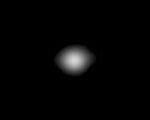 Image of Adrastea taken by Galileo spacecraft between November 1996 and June 1997 | |
| Discovery | |
|---|---|
| Discovered by |
|
| Discovery date | 8 July 1979 |
| Designations | |
| Pronunciation | /ædrəˈstiːə/[1] |
Named after | Ἀδράστεια Adrasteia |
| Adjectives | Adrastean /ædrəˈstiːən/[2] |
| Orbital characteristics | |
Mean orbit radius | 129000 km[3][4] |
| Eccentricity | 0.0015[3][4] |
| 0.29826 d (7 h, 9.5 min)[3][4] | |
Average orbital speed | 31.378 km/s[a] |
| Inclination | 0.03° (to Jupiter's equator)[3][4] |
| Satellite of | Jupiter |
| Physical characteristics | |
| Dimensions | 20 × 16 × 14 km[5] |
| 8.2±2.0 km[5] | |
| Volume | ≈ 2345 km3[a] |
| synchronous | |
| zero[5] | |
| Albedo | 0.10±0.045[5] |
| Temperature | ≈ 122 K |
Adrastea (/ædrəˈstiːə/), also known as Jupiter XV, is the second by distance, and the smallest of the four inner moons of Jupiter. It was discovered in photographs taken by Voyager 2 in 1979, making it the first natural satellite to be discovered from images taken by an interplanetary spacecraft, rather than through a telescope.[6] It was officially named after the mythological Adrasteia, foster mother of the Greek god Zeus—the equivalent of the Roman god Jupiter.[7]
Adrastea is one of the few moons in the Solar System known to orbit its planet in less than the length of that planet's day. It orbits at the edge of Jupiter's main ring and is thought to be the main contributor of material to the rings of Jupiter. Despite observations made in the 1990s by the Galileo spacecraft, very little is known about the moon's physical characteristics other than its size and the fact that it is tidally locked to Jupiter.
- ^ as "Adrastia" in Noah Webster (1884) A Practical Dictionary of the English Language
- ^ A.H. Clough (1905) Plutarch's lives: the translation called Dryden's, vol. 3, p. 238.
- ^ a b c d Evans Porco et al. 2002.
- ^ a b c d Burns Simonelli et al. 2004.
- ^ a b c d Thomas Burns et al. 1998.
- ^ IAUC 3454.
- ^ IAUC 3872.
Cite error: There are <ref group=lower-alpha> tags or {{efn}} templates on this page, but the references will not show without a {{reflist|group=lower-alpha}} template or {{notelist}} template (see the help page).